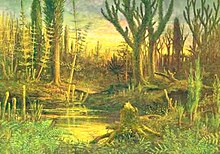Colonization of land
Artist's conception of Devonian flora
Oxygen accumulation from photosynthesis resulted in the formation of an ozone layer that absorbed much of the Sun's ultraviolet radiation, meaning unicellular organisms that reached land were less likely to die, and prokaryotes began to multiply and become better adapted to survival out of the water. Prokaryote lineages had probably colonized the land as early as 2.6 Gaeven before the origin of the eukaryotes. For a long time, the land remained barren of multicellular organisms. The supercontinent Pannotia formed around 600 Ma and then broke apart a short 50 million years later.Fish, the earliest vertebrates, evolved in the oceans around 530 Ma.A major extinction event occurred near the end of the Cambrian period,which ended 488 Ma.
Several hundred million years ago, plants (probably resembling algae) and fungi started growing at the edges of the water, and then out of it.The oldest fossils of land fungi and plants date to 480–460 Ma, though molecular evidence suggests the fungi may have colonized the land as early as 1000 Ma and the plants 700 Ma.Initially remaining close to the water's edge, mutations and variations resulted in further colonization of this new environment. The timing of the first animals to leave the oceans is not precisely known: the oldest clear evidence is of arthropods on land around 450 Ma, perhaps thriving and becoming better adapted due to the vast food source provided by the terrestrial plants. There is also unconfirmed evidence that arthropods may have appeared on land as early as 530 Ma.




Comments
Post a Comment